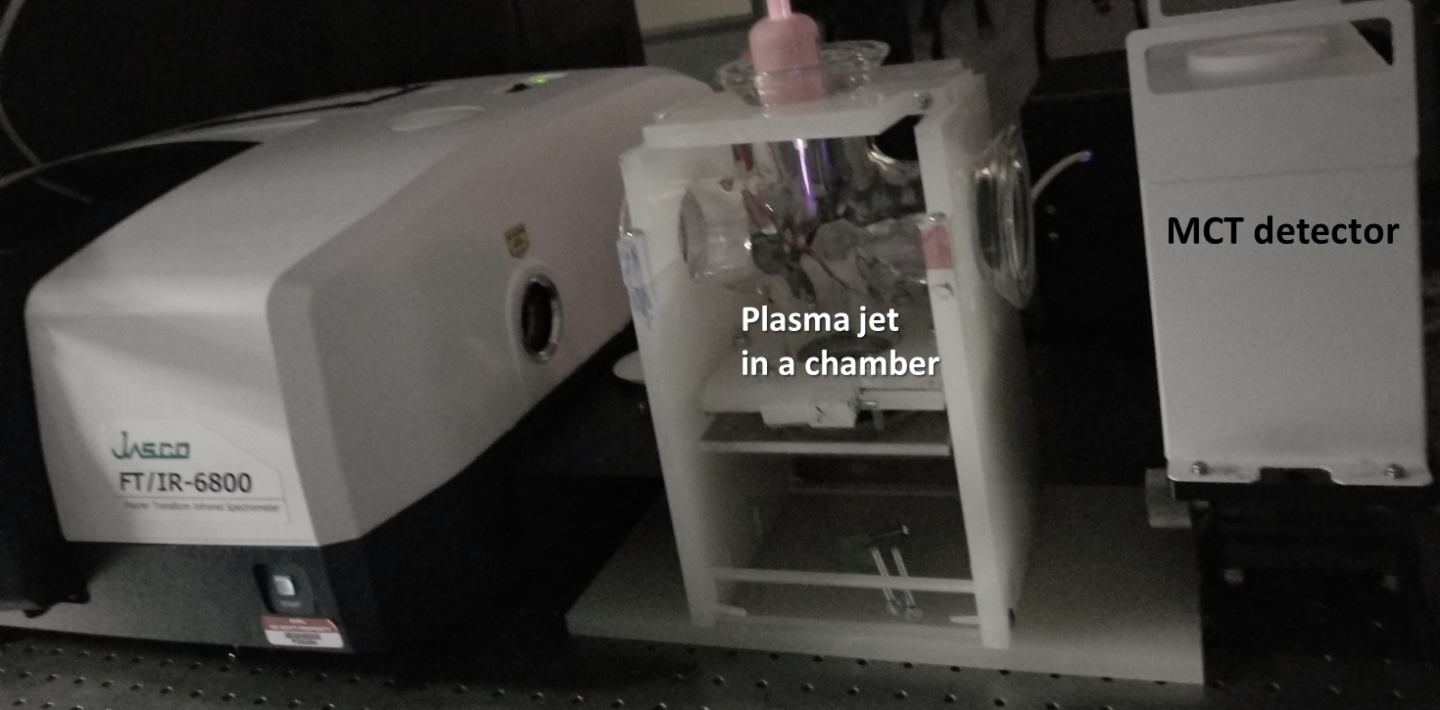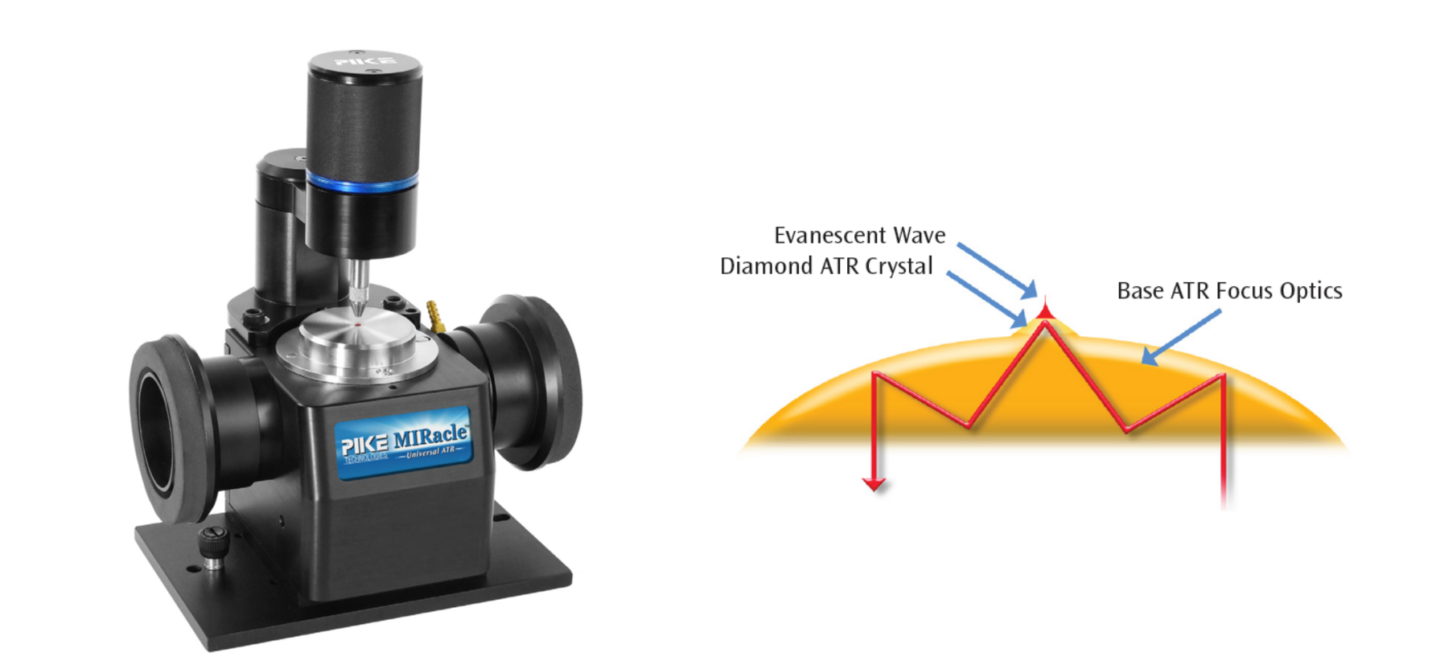Fourier Transform Infrared Spectrometry
Advanced Diagnostics Navigation
- Atomic and molecular species, positive and negative ions
- Laser-Induced Fluorescence (LIF) and Two-Photon Absorption LIF (TALIF)
- Characterization of plasma, chemical composition and dynamic behavior
- Electron velocity distribution function, gas flow velocity and temperature
- Electric field and space potential
- Nanoparticle Diagnostics
- Surface Diagnostics
Fourier Transform Infrared Absorption Spectrometry
Fourier Transform Infrared Absorption Spectrometry (FTIR-AS)

IRAS detects stretching and bending vibrations of interatomic bonds that involve changing the dipole moments of the molecules, which gives access to hetero-nuclear (OH, CO, CH, NO) and poly-atomic molecular species (CH_3, CH_4, SiH_4, CO_2, NH_4), and larger molecules alcohols, aldehydes, and aromatic compounds. FTIR spectrometer measures the absorption spectrum of a gas, plasma, liquid, or solid sample over a broad range spectral range with high spectral resolution in one sweep. A beam passing through a sample is optically guided through an interferometer and an interferogram is recorded on a cooled detector. The spectrometer software then uses the Fourier Transform to convert the interferogram into a spectrum. The spectra of these and other molecules are well documented in the HITRAN database . The advantage of the FTIR diagnostics for plasma sources is that it allows detection of multiple gas species simultaneously, including multi-atomic species, which are not detectable with optical emission spectroscopy and laser-induced fluorescence. FTIRAS is a fully optical, non-intrusive technique, as opposed to residual gas analyzer or mass spectrometry. The disadvantage of the FTIRAS approach is its relative lack of sensitivity and the fact that it lacks spatial resolution, where the absorption is integrated along the line-of-sight.

PPPL-PU facilities are equipped with an FTIR Spectrometer (JASCO-FTIR 6800) with a standard Peltier cooled detector and a HgCdTe (MCT) detector cooled by liquid nitrogen. Sampling cells for gas, liquid, and solid samples fit into the main chamber of the spectrometer for use with either the standard or the MCT detector. In addition, the MCT detector can be positioned over 1 m away from the FTIR main unit which allows the IR beam to pass through external plasma sources as shown in Figure FR-5. The versatility of this configuration combined with the sensitivity and relatively high scanning speed (~0.1 s per scan at 4 cm-1 resolution) makes it easy to adopt for monitoring gas emission from plasma processing chambers, for in situ study of plasma chemical composition, and for in situ studies of plasma-liquid interaction and plasma-solid interaction. FTIR allows direct access to the surface composition by measuring the reflection spectra such as the attenuated total reflection (ATR) or for increased sensitivity, multiple reflection (MIR) spectra or direct reflection (DRIFFTs) for in situ studies. The choice of the reflection and transmission methods used for plasma-surface interaction depends on the plasma and the type of surface. For example, transmission techniques can be used for the study the effect of plasma on tissue cells, while the external MCT detector and the DRIFTS technique could be used for the study of medical plasma-surface interactions, or plasma-liquid interactions.
Fourier Transform Infrared Attenuated Total Reflectance (FTIR-ATR)
In addition to Fourier Transform Infrared (FTIR) absorption spectroscopy (AS), PCRF also offers attenuated total reflectance (ATR) FTIR using a PIKE MIRacle ATR with 3-reflection with diamond/ZnSe crystal plates. This method is suitable for the analysis of solid and liquid samples and provides information about the functional groups and the chemical structure of materials near the surface (~ 1 μm) of an internal reflection element (IRE). Spectral changes can be used to detect the qualitative and quantitative changes in the chemical composition of a sample near the surface following plasma modification of either the sample or its environment (ex. liquid). A key advantage of this method as compared to FTIR AS is its ability to collect accurate spectra in the presence of water including solid-liquid interfaces.

 This capability is located at the Princeton Plasma Physics Laboratory.
This capability is located at the Princeton Plasma Physics Laboratory.


